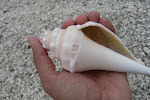The traditional or classical characteristic of the beads are disc shaped, orange in color, highly polished and without any surface blemish. Their dimensions are generally about 10 to 20 mm in diameter, 1 to 2.5 mm in width, and weighing about .5 to 2.5 grams. Most beads are biconically (two cones) drilled from both the front and the back surface but some are drilled completely through. Most beads have holes drilled in the center of the disc. There is a picture of some bead artifacts found on Tumon Bay, Guam here: http://historicguam.org/Historic%20Preservation%20Plan%20for%20Guam.pdf
Below is a picture of some ancient Spondylus disc beads housed in the CNMI Museum of History and Culture in Garapan, Saipan. The biggest disc bead here is about 51 mm in diameter. Look closely, and you’ll see that this particular bead has two holes to accommodate binding. Can you see the conically shaped drill hole of the top middle bead?

The next two pictures are also from the museum. It's a display collection of different ornamental artifacts collected by former United States Marine lieutenant and archeologist/naturalist Hans Hornbostle in the 1920s. According to the label, the artifacts were returned to Saipan by the Bishop Museum in Honolulu Hawaii in 1999.


After learning a little about the history of these artifacts and seeing how beautiful they are, I was hooked. I decided that I too would like to embark on a creative journey, much like the ancient people of my adoptive island home. So I “cut”, polish and bind my own versions of the Spondylus salape’ to give homage to the past and hopefully inspire others to discover for themselves the beauty of the ancient Chamorro culture.
This is a finished necklace and some bead discs that are ready to be bound. You can see that the Spondylus varies greatly in color which we shall explore on an upcoming post.

Finally, here are three more finished necklaces all in the classical shape of the Spondylus salape’ (the bead on the left is a toggle that closes the loop of a necklace. These are bound by beading cord of 100 % cotton.

Thank you for letting me share once again.
The Beachcomber


6 comments:
which one is mine?!
Very cool, your blog is going to be a welcome addition to what is being offered to bring awareness to the underwater world. Thanks for bringing the scientific aspect of it and the historical aspect as well. I look forward to reading your posts.
Beautiful work and a great blog. Hope you don't mind if I link you!
Even beachcombers? Now everybody's got a blog!
Nice work on the salape' pendants. I'll trade with you, salape' for salape'.
Now I want to go comb the beach and find some spondylus.
By the way, what beach having you been combing for spondylus? The only beach I have been able to find any real substantial pieces on is Obyan..
Bev: Wait a bit & I will post about the piece I put together while you were on my mind.
Harry: Some posts will speak for the nerd in me. Thank you for your friendship and keep tuned in for more Spondylus biology that will include your pics in situ.
Lewie: I was going to join the Christmas Art Sale this weekend, but they ran out of space. If you find any good fragments and have an idea for a piece, I’ll cut it for you.
Tamara: Thanks for the link and you have a beautiful family. You can find fragments practically on any beach on Saipan, but you are spot on when you said that it is hard to find a good size/quality piece. But I hope to post on some fragments that I thought were pretty much useless until I spent some extra time working on them. Some have turned out into jewels! Like I told Harry, I will post on a biology topic soon to cover the different species, some of which are of very different colors and patterns from the classical colors.
Post a Comment